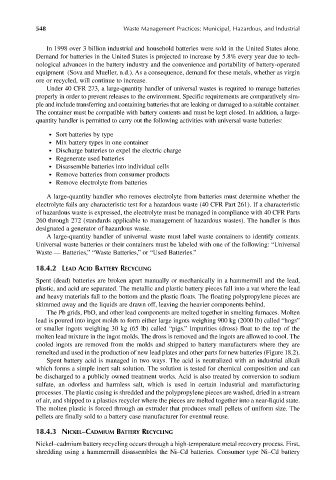Page 577 - Materials Chemistry, Second Edition
P. 577
CAT3525_C18.qxd 1/27/2005 12:47 PM Page 548
548 Waste Management Practices: Municipal, Hazardous, and Industrial
In 1998 over 3 billion industrial and household batteries were sold in the United States alone.
Demand for batteries in the United States is projected to increase by 5.8% every year due to tech-
nological advances in the battery industry and the convenience and portability of battery-operated
equipment (Sova and Mueller, n.d.). As a consequence, demand for these metals, whether as virgin
ore or recycled, will continue to increase.
Under 40 CFR 273, a large-quantity handler of universal wastes is required to manage batteries
properly in order to prevent releases to the environment. Specific requirements are comparatively sim-
ple and include transferring and containing batteries that are leaking or damaged to a suitable container.
The container must be compatible with battery contents and must be kept closed. In addition, a large-
quantity handler is permitted to carry out the following activities with universal waste batteries:
● Sort batteries by type
● Mix battery types in one container
● Discharge batteries to expel the electric charge
● Regenerate used batteries
● Disassemble batteries into individual cells
● Remove batteries from consumer products
● Remove electrolyte from batteries
A large-quantity handler who removes electrolyte from batteries must determine whether the
electrolyte fails any characteristic test for a hazardous waste (40 CFR Part 261). If a characteristic
of hazardous waste is expressed, the electrolyte must be managed in compliance with 40 CFR Parts
260 through 272 (standards applicable to management of hazardous wastes). The handler is thus
designated a generator of hazardous waste.
A large-quantity handler of universal waste must label waste containers to identify contents.
Universal waste batteries or their containers must be labeled with one of the following: “Universal
Waste — Batteries,” “Waste Batteries,” or “Used Batteries.”
18.4.2 LEAD ACID BATTERY RECYCLING
Spent (dead) batteries are broken apart manually or mechanically in a hammermill and the lead,
plastic, and acid are separated. The metallic and plastic battery pieces fall into a vat where the lead
and heavy materials fall to the bottom and the plastic floats. The floating polypropylene pieces are
skimmed away and the liquids are drawn off, leaving the heavier components behind.
The Pb grids, PbO, and other lead components are melted together in smelting furnaces. Molten
lead is poured into ingot molds to form either large ingots weighing 900 kg (2000 lb) called “hogs”
or smaller ingots weighing 30 kg (65 lb) called “pigs.” Impurities (dross) float to the top of the
molten lead mixture in the ingot molds. The dross is removed and the ingots are allowed to cool. The
cooled ingots are removed from the molds and shipped to battery manufacturers where they are
remelted and used in the production of new lead plates and other parts for new batteries (Figure 18.2).
Spent battery acid is managed in two ways. The acid is neutralized with an industrial alkali
which forms a simple inert salt solution. The solution is tested for chemical composition and can
be discharged to a publicly owned treatment works. Acid is also treated by conversion to sodium
sulfate, an odorless and harmless salt, which is used in certain industrial and manufacturing
processes. The plastic casing is shredded and the polypropylene pieces are washed, dried in a stream
of air, and shipped to a plastics recycler where the pieces are melted together into a near-liquid state.
The molten plastic is forced through an extruder that produces small pellets of uniform size. The
pellets are finally sold to a battery case manufacturer for eventual reuse.
18.4.3 NICKEL–CADMIUM BATTERY RECYCLING
Nickel–cadmium battery recycling occurs through a high-temperature metal recovery process. First,
shredding using a hammermill disassembles the Ni–Cd batteries. Consumer type Ni–Cd battery

